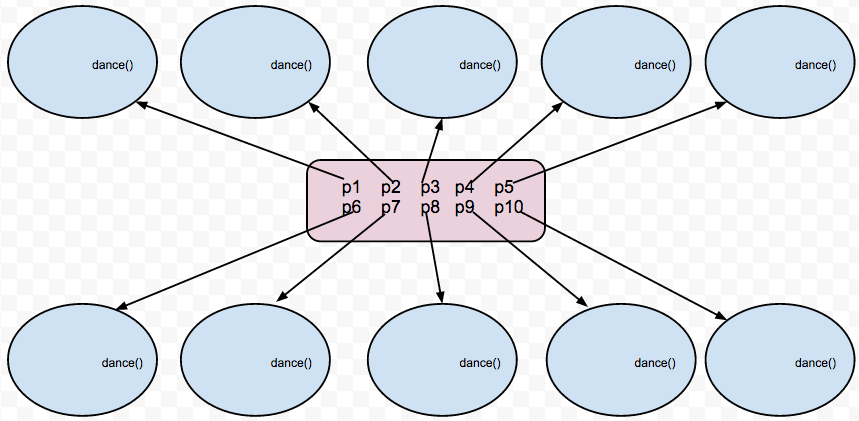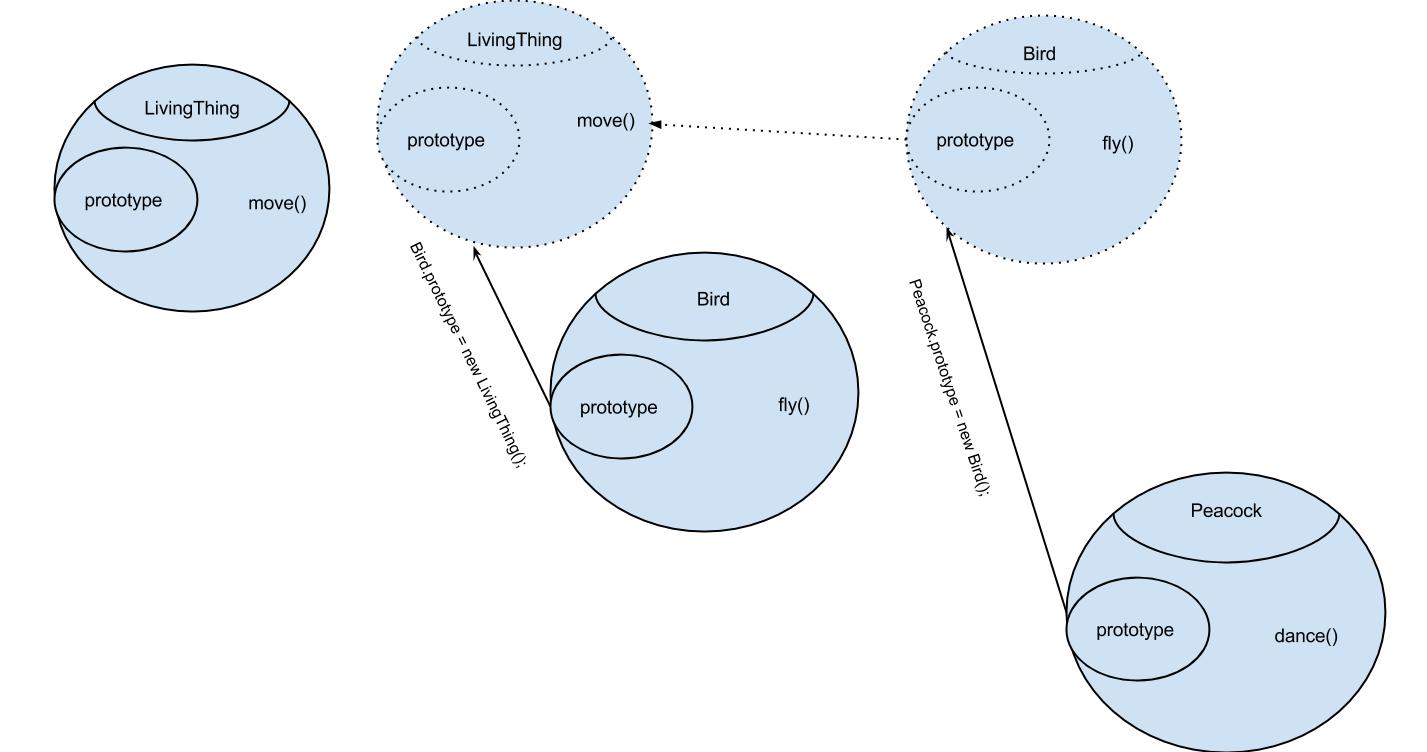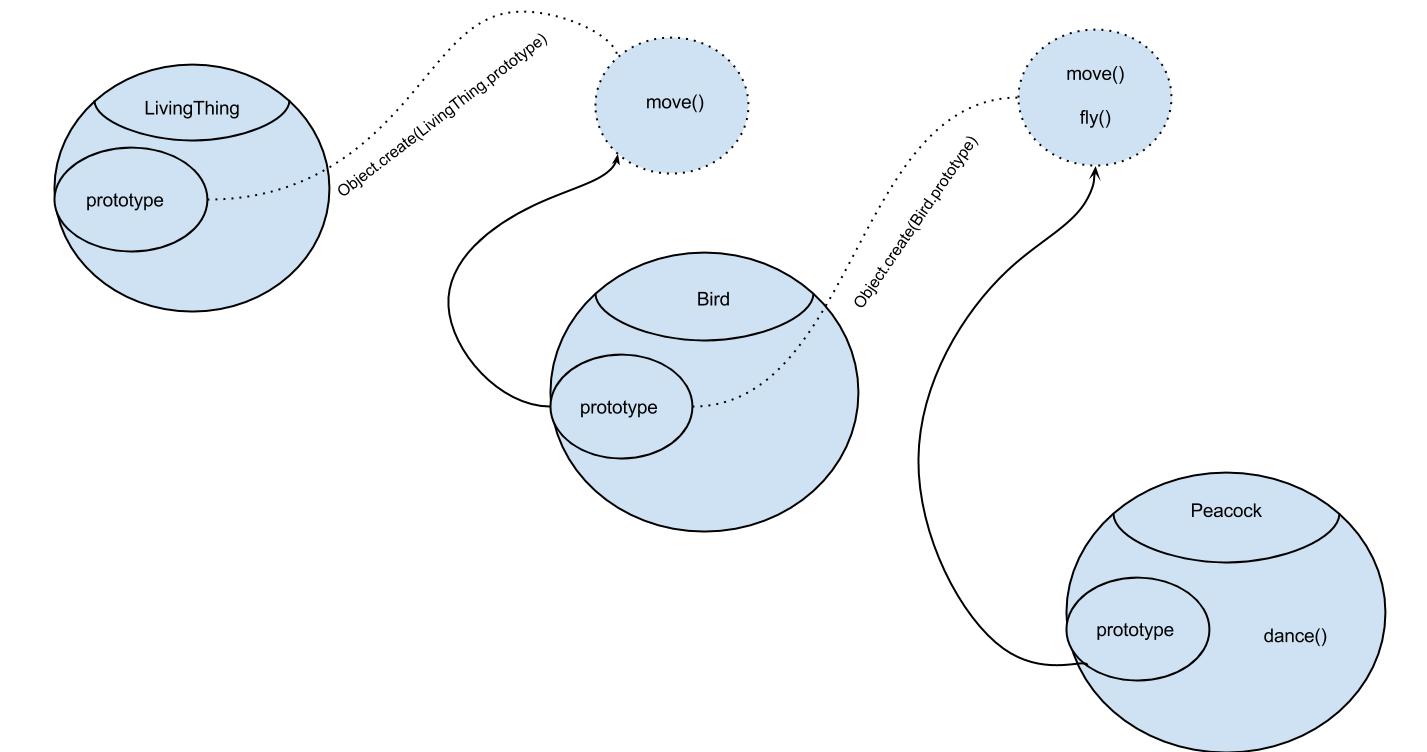#JavaScript Inheritance Revisited
In one of my previous blogs, I had talked about inheritance in JavaScript. The main idea of that blog was to share that how inheritance can be achieved using prototype chaining.
But the demo given in the that blog had some serious flaws or if not a flaw then you can say a bad advice or maybe not a good way to implement inheritance.
Demo in the previous blog on inheritance looked like:
function LivingThing() {
this.move = function() {
console.log("I am living thing! I can move!!");
};
}
function Bird() {
this.fly = function() {
console.log("I am bird! I can fly!!");
};
}
function Peacock() {
this.dance = function() {
console.log("I am Peacock! I can dance");
};
}
Bird.prototype = new LivingThing();
Bird.prototype.constructor = Bird;
Peacock.prototype = new Bird();
Peacock.prototype.constructor = Peacock;
var peacock = new Peacock("A");
peacock.dance(); // I am Peacock! I can dance
peacock.fly(); // I am bird! I can fly!!
peacock.move(); // I am living thing! I can move!!
So let’s first discuss the problems with the above piece of code then we will discuss the solution!
First Problem: We were defining a function inside the constructor function, so every time a new object would be created, it would get its own copy of that member function.
Old Peacock Class:
function Peacock() {
this.dance = function() {
console.log("I am Peacock! I can dance");
};
}
Now suppose of there are 10 Peacock objects in the chain, then 10 dance() functions would also be there(Each object would be having a dance() function which is defined in constructor function) because we know that functions are data in JavaScript, therefore if one function takes 10 bytes of data then 10 objects would obviously take 100 bytes which is quite an inefficient way of doing things. See this diagrammatic representation showing what will happen if numerous Peacock objects are created:

NOTE: If we are defining 5 functions into constructor function, and each function takes 10 bytes then each object will take 50 bytes and 10 objects will take 10*50=500 bytes. And memory will continuously increase by 50 bytes with each object, which is seriously a bad way.
Second Problem: When we do Peacock.prototype = new Bird();, a new Bird object would be created, and stored to Peacock prototype. So all the Peacock objects are now having same object in prototype as parent object(Bird object). As all the Peacock objects have single parent Bird object, so whatever we will change in that Bird object, will be reflect for all the child peacock objects. If one child object will update any parent property, it will be updated for all other child peacock objects, which is not correct inheritance.
function Bird() {
this.birdProperty = {
flySpeed:'20m/s',
maxHeight:'5km'
};
}
function Peacock() {
}
Peacock.prototype = new Bird();
Peacock.prototype.constructor = Peacock;
var p1 = new Peacock();
var p2 = new Peacock();
console.log("p1's parent Properties", p1.birdProperty); // { flySpeed: '20m/s', maxHeight: '5km' }
console.log("p2's parent Properties", p2.birdProperty); // { flySpeed: '20m/s', maxHeight: '5km' }
p1.birdProperty.flySpeed = '30m/s';
console.log("p1's parent Properties", p1.birdProperty); // { flySpeed: '30m/s', maxHeight: '5km' }
console.log("p2's parent Properties", p2.birdProperty); // { flySpeed: '30m/s', maxHeight: '5km' }
NOTE: Here we can notice that we were updating flySpeed of peacock p1, and peacock p2’s flySpeed has been updated too.
Third Problem: If we would try to update parent property via child object, and if property is primitive then it will create a new property in child object instead of updating parent property, and same thing will apply to object if we assign new object. When we assign new object in any variable then it will create a new variable in child object and assign reference of that newly created object into that newly created variable(So there will be two variables with same name, one in parent Bird object and second in child Peacock object so it may give you wrong/unexpected results.). But if you are updating any property of object value, then it will get updated in parent object property(As discussed in Second Problem.).
Fourth Problem: Suppose LivingThing class has a property with name food, which is set into Constructor function as below:
function LivingThing(food) {
this.food = food;
}
And Bird class also has a property named flySpeed, which is also set into Constructor function, and user can also pass food property along with flySpeed to set, as Bird is child class of LivingThing So it should have food property as well:
function Bird(food, flySpeed) {
// How to set food property as it is declare in parent class ??
this.flySpeed = flySpeed;
}
And Peacock class also has a property named color, which is also set into Constructor function and user can also pass food and flySpeed properties along with color, as Peacock is child class of Bird so it should have food and flySpeed properties too.
function Peacock(food, flySpeed, color) {
// How to set food and flySpeed properties as it is declared in parent class ??
this.color = color;
}
And whenever user is creating an object of Peacock class, he will be assuming that he will pass all three properties color, flySpeed and food(e.g. var peacock = new Peacock("White", "10m/s", "snakes")) and all of these properties will be set. But that is not the case is happening here.

Above diagram shows how inheritance is happening through prototype chaining in and in addition to it, it also shows that how function declared in super class is available in the further sub classes also.
So what is the better approach? How to avoid function getting created with each object? How to implement right inheritance? And how to solve all above problems?
The Solution:
First Solution: Let’s keep the function of constructor function at place which is common, so that they can be accessed by all the Peacock object. To do this let’s make this function static and to make a function static in JavaScript, all we have to do is put that function in the prototype.
So, instead of creating function dance() inside the constructor function of Peacock, create it inside the prototype of Peacock so it will be common for all the objects.
New Peacock Class:
function Peacock() {
}
Peacock.prototype.dance = function () {
console.log("I am Peacock! I can dance!!");
};
Now if we create multiple objects of Peacock class then all the Peacock objects will be having same object in prototype property, so all the Peacock object will get dance() method via prototype chaining. Now dance() method will take memory once only. :-)
NOTE: With the help of this solution, our First Problem will be solved. :-)
Second Solution: Create an object of prototype and pass it in the prototype of next object. So Inheritance will perform for static/ prototype members. This can be seen in the snippet below:
// LivingThing Class
function LivingThing() {
}
LivingThing.prototype.move = function () {
console.log("I am living thing! I can move!!");
};
// Bird Class
function Bird() {
}
Bird.prototype = Object.create(LivingThing.prototype);
Bird.prototype.constructor = Bird;
Bird.prototype.fly = function () {
console.log("I am bird! I can fly!!");
};
// Peacock Class
function Peacock() {
}
Peacock.prototype = Object.create(Bird.prototype);
Peacock.prototype.constructor = Peacock;
Peacock.prototype.dance = function () {
console.log("I am Peacock! I can dance!!");
};
var peacock = new Peacock("White", "10m/s", "snakes");
peacock.dance(); // I am Peacock! I can dance!!
peacock.fly(); // I am bird! I can fly!!
peacock.move(); // I am living thing! I can move!!
In the above snippet, we have passed the copy of prototype object of LivingThing class in the prototype of Bird class, with the help of Object.create, as Bird.prototype = Object.create(LivingThing.prototype).
Similarly, in the prototype of Peacock class, we have passed the copy of prototype object of Bird class with the help of Object.create() as Peacock.prototype = Object.create(Bird.prototype);.
Object.create was basically takes following two arguments(second one being the optional):
- Prototype
- Set of properties
On the basis of prototype and set of properties passed Object.create creates a new object.
Let’s us see a diagrammatic representation of the snippet given above:

Third Solution: We passed some properties to our Peacock object which could not be done in the previous implementation. What if we passed “White” , “10m/s” and “snakes” to our Peacock object?
For this problem, we have to call parent class constructor into child class constructor like other languages. In other languages, when we call parent class constructor from child class constructor, then parent class constructor is called with same object/reference of child class object. So we have to take care of both the things - Calling parent class constructor into child class constructor and calling the parent class constructor with the reference of child class object only. Calling parent class constructor into child class constructor is very easy and for calling parent class constructor with same child class object’s reference, we can use JavaScript delegation feature( call/ apply).
// LivingThing Class
function LivingThing(food) {
this.food = food;
}
LivingThing.prototype.move = function () {
console.log("I am living thing! I can move!! And I eat: ", this.food);
};
// Bird Class
function Bird(food, flySpeed) {
LivingThing.apply(this, [food]);
this.flySpeed = flySpeed;
}
Bird.prototype = Object.create(LivingThing.prototype);
Bird.prototype.constructor = Bird;
Bird.prototype.fly = function () {
console.log("I am bird! I can fly!! And My speed is: ", this.flySpeed);
};
// Peacock Class
function Peacock(food, flySpeed, color) {
Bird.call(this, food, flySpeed);
this.color = color;
}
Peacock.prototype = Object.create(Bird.prototype);
Peacock.prototype.constructor = Peacock;
Peacock.prototype.dance = function () {
console.log("I am Peacock! I can dance!! And my Color is: ", this.color);
};
var peacock = new Peacock("snakes", "10m/s", "While");
peacock.dance(); // I am Peacock! I can dance!! And my Color is: While
peacock.fly(); // I am bird! I can fly!! And My speed is: 10m/s
peacock.move(); // I am living thing! I can move!! And I eat: snakes
Closely see the Peacock function and notice that we have made the Bird function point to the Peacock object. We have used call here as we know that there is no super keyword in JavaScript to point to the parent constructor. Similarily, we have made LivingThing function point to the peacock object. So the gist is that we are executing LivingThing and Bird functions in context to Peacock object only.
NOTE: With the help of second and third solution, our remaining Problem will solve. :-)
There are a lot of ways to achieve a single thing, but it depends upon the need of the project and the situation that one can decide which way to adopt!